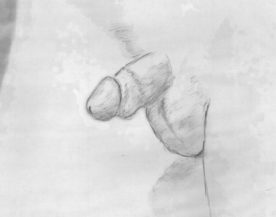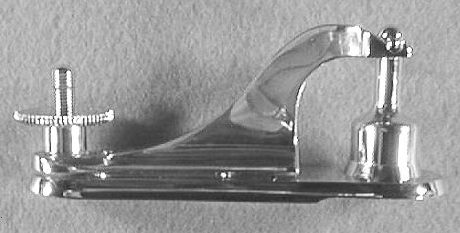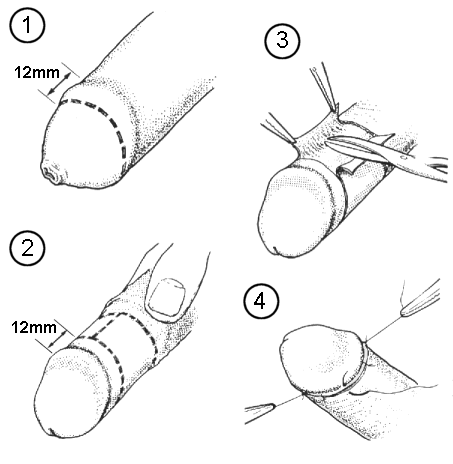
The outer foreskin and some shaft skin has been removed, but much of the inner foreskin was left, resulting in a complete circumcision with the scar part way down the shaft
There are many different ways of removing the surplus skin which folds over the glans to form the foreskin, and it is differences between these methods that accounts for much of the variation in results.
Infant circumcision
 |
Circumcised penis of a young boy The outer foreskin and some shaft skin has been removed, but much of the inner foreskin was left, resulting in a complete circumcision with the scar part way down the shaft |
While there is no absolute difference between circumcising infants, older children and adults, in practice different approaches are often used, so it is convenient to think of these as different operations. Mechanical devices have been devised to simplify neonatal circumcision in countries where it is the norm, and these are rarely used on adults.
One of the simplest and commonest methods used nowadays is a direct descendant from traditional techniques. The foreskin is pulled forwards and gripped in a pair of clamping or crushing forceps, placed at an angle to match the slope of the back of the glans. The pressure helps to prevent bleeding. The skin is cut off in front of the blades of the forceps; the inner skin is pushed back and fastened with sutures (stitches) to the outer skin on the shaft. In infancy (and in third-world countries even with older boys) the sutures are often dispensed with, since their main purpose in any case is to close off blood vessels, and the crushing with the forceps is often enough to accomplish this (see paper by Awojobi).
How complete the circumcision is will depend on how hard the skin is pulled forward before it is clamped, but making the cut while the skin is pulled over the glans provides a safeguard against removing too much. Much of the inner skin remains, so the scar, after healing, will be well down the shaft. It is usually somewhat irregular but very inconspicuous.
This type of operation is common in the UK and Australia, and also in developed Muslim and African countries. It is also appropriate for use on older boys though in this case sutures are always required.
GOMCO CLAMP

The Gomco clamp assembled
The Gomco Clamp is very popular in the USA - probably the majority of American circumcisions are carried out with it. The foreskin is retracted, and a metal cap is placed over the glans. The skin is then pulled forward again, over the cap. A clamp is fitted which compresses the skin tightly against the base of the cap, preventing bleeding while the skin is cut off. Then the clamp is released, the cap removed and a few sutures inserted. Since the cut is made at the base of the glans much of the inner skin will be removed, but the final result will vary from radical to moderate depending on how much skin was pulled forwards. The scar is typically a dead straight line around the penis.
The Plastibell is a disposable, single-use circumcision aid. This has a partial cap (like a broad ring with a groove in it) which fits over the base of the glans, and has a handle attached. The foreskin is partially slit so that the glans can easily be exposed and the appropriate size Plastibell placed in position. The skin is then pulled forward over the ring, and a tie is fixed tightly around, compressing it into the groove. The surplus skin is cut off in front of the tie, which prevents any bleeding. The snap-off handle of the Plastibell is then removed, leaving the ring in place. In 5-8 days the ring, with the tie and the fringe of now dead skin in front of it, falls off leaving a clean, healed line10. The Plastibell has gained some favour in Denmark as a means of carrying out a partial circumcision; most boys there are left natural and leaving some foreskin makes a circumcised boy less 'different'. On the other hand, it is also very popular in Saudi Arabia where a fully uncovered glans is required. Thus the extent to which the skin is pulled forward before the tie is applied can give a range of outcomes, though a certain amount of free skin usually remains.
Operating on an adult
Operations on older boys and adults are typically done freehand, without mechanical aids. A popular technique involves first slitting the foreskin from the opening down to the corona of the glans, then cutting around from there. One published procedure lays down rules to ensure a predictable result. First the foreskin is cut down from the tip to the ridge of the glans on top. Then a second, shorter cut is made down the lower side of the foreskin to the point where the frenulum joins the glans. A straight line is marked, on each side, between the ends of the two cuts, and the outer skin is cut along this line. Then the inner skin is trimmed to leave a short collar which is sutured to the cut edge of the outer skin. This technique will always give a moderate circumcision, with not much inner skin remaining. Freehand circumcision along these lines is also sometimes done on infants.

A method popular among specialist urologists involves removing only the surface layer of skin, carefully avoiding cutting any blood vessels and the loose connective tissue layers beneath the surface. Lines are marked on the skin (1 & 2) and the surface skin is removed between them (3). The edges are brought together and stitched (4), with the remaining blood vessels looping around beneath the surface, where they seem to cause no problem. Since no blood vessels have been cut, bleeding is minimal - no dressing is needed, and healing is rapid. The end result can be anything from a complete to a partial circumcision, depending on the way the initial marks were made, but the measurements shown in Lucas' diagram, reproduced here, would leave quite a lot of loose skin.
There are many different ways of carrying out the operation of circumcision. For an adult sleeve resection offers minimum trauma and fastest healing, but because the operation is relatively complex it will usually require a general anaesthetic.